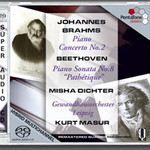
Brahms: Piano Concerto No. 2 in B flat / Beethoven: Piano Sonata No.8 in C minor Pathetique
 $37.00
Out of Stock
$37.00
Out of Stock6+ weeks add to cart
JOHANNES BRAHMS / LUDWIG van BEETHOVEN
Brahms: Piano Concerto No. 2 in B flat / Beethoven: Piano Sonata No.8 in C minor Pathetique
Misha Dichter (piano / Gewandhausorchester Leipzig / Kurt Masur
[ Pentatone SACD / Hybrid SACD ]
Release Date: Friday 18 August 2006
This item is currently out of stock. It may take 6 or more weeks to obtain from when you place your order as this is a specialist product.
Brahms probably wrestled with his Piano Concerto No. 1, Op. 15 to a greater degree and for a longer period of time than with any other work.
Hybrid/SACD DSD remastered Playable on all compactdisc players
Brahms probably wrestled with his Piano Concerto No. 1, Op. 15 to a greater degree and for a longer period of time than with any other work. Following its première in 1859, and especially after the scandal in Leipzig, Brahms considered the work to be a flop; yet he wrote to Joseph Joachim full of pride: "Despite all this, the concerto will be a success at some time, as I have improved its structure, and a second concerto will have to sound quite different." Brahms was to be proved right in both statements - even though he took some time making the changes. It took more than 20 years following his first contribution to the genre for Brahms to once again devote himself to the piano concerto; in the summer of 1878, he began his Piano Concerto in B flat, although he stopped work on it for three years and did not complete it until 1881 in Pressbaum, near Vienna. He dedicated the concerto to his piano and composition teacher, Eduard Marxsen.
In the B-flat Concerto, Brahms successfully implemented the idea of the "symphonic concerto". Here, he realized the creation of a symphony for piano and orchestra, in which both partners enjoy absolutely equal rights. We gather from a quote from a letter written to Elisabeth von Herzogenberg that Brahms was capable of self-irony: "I want to tell you that I have written a very small piano concerto with a very small, fragile scherzo." The understatement becomes especially clear when one takes a close look at the huge dimensions of the work. Awaiting the listener are forty-five minutes of playing-time and four movements, in which Brahms presents his individual interpretation and his feeling for the form and content.
Although the first movement is still based on the traditional sonata form, this is modified: the easily recognizable sections of the exposition, development and recapitulation are accompanied by both an introduction and a coda. In the introduction, something important happens straight away: the romantic main theme is given to the solo horn, the main key is presented clearly and the harmony is unambiguous, whereby the theme is ended openly on the dominant. The piano plays a complementary echo. During the further course of the movement, Brahms starts searching for a suitable cliché for the end of the first theme; all other activities are irrelevant. The soloist does not play any distracting cadenzas, rather he remains a structural part of the search, during the course of which other, varying intrigues are brought on. Not until the Coda does the first theme find its end on the tonic. The second movement is a surly Scherzo, with a monothematic character. The Trio does not bring tranquillity; rather it drives the movement ever forward. In the Andante, Brahms finds the lyrical climax of the concerto: it begins with a lyrical song on the cello, while the piano takes on an increasingly virtuoso role. The Finale is a sonata rondo, a last dance based on Hungarian melodies, which is not so much subjected to variation as rather presented by different instrument groups. Here, piano and orchestra carry on a most intensive dialogue, which leads to an increasingly accelerating and brilliant Coda.
In his piano sonatas, Beethoven managed to achieve something well-nigh unimaginable - during the enormous gap between Op. 2 (1793-95) and Op.111(1821/22), he came up with no less than 32 proposals for solutions in composition, whose respective differences can be assessed as resolute and radical.
In his Sonata in C-minor, Op. 13, which dates from 1798/99 and was first published in Vienna in 1799, Beethoven's sonata skills achieved their first enormous climax. The work, which was dedicated to his patron and friend Prince Carl von Lichnowsky, bears the title "Grande Sonate Pathétique", chosen by the composer himself.
Already in the first movement, Beethoven trod an entirely new path with a 10-bar Grave-introduction derived from the symphonic tradition, which returns at important places in the movement - i.e. at the beginning of the development and before the Coda - and represents a strong contrast to the insistent fighting spirit of the Allegro di molto e con brio, of which the main part consists. These dialectics, consisting of slow and fast segments, determine both the structure and the content of the first movement. Beethoven links melodramatic effects, which function as a signal, with individual experiences: plunging chromatic scales, diminished sevenths and wild octave tremolos dominate the musical scene. The lyrical Adagio offers pure relaxation to both the pianist and the listener after the dramatic beginning of the work: it is an "Oasis of hymnic serenity" (Kinderman) in A flat. The song-like melody ranges upward from the middle to the soprano register, supported by the contrapuntal bass line and harmonic deviations. In the Rondo-Finale, which demonstrates a clear imitation of the main sonata-movement form, one becomes aware of the fluctuation between despair and hope, until an abrupt crash in triplets energetically and inexorably erases all expectations.
Tracks:
JOHANNES BRAHMS
Piano Concerto No. 2 in B flat, Op.83
LUDWIG VAN BEETHOVEN
Piano Sonata No.8 in C minor, Op.13 "Pathétique"



